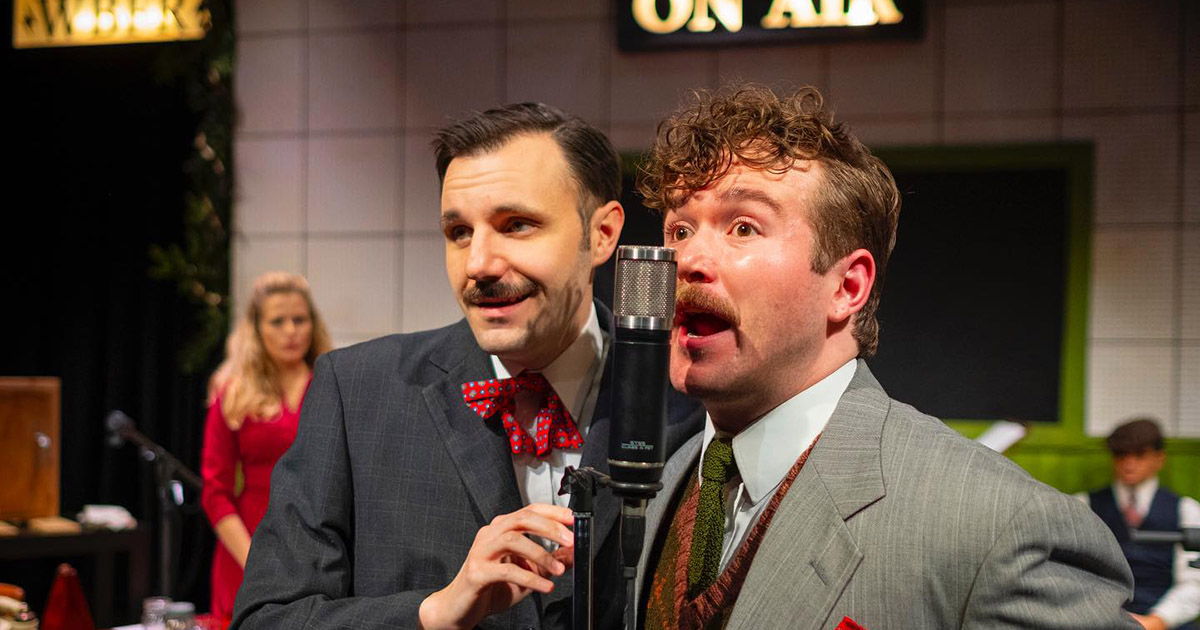Live theatre, by its very nature, asks a number of things of its audience. First, one must accept that a theatre experience is almost always presentational, not reality. And, of course, there are a host of literary and visual devices—symbolism, metaphor, and allusion among them—that one might encounter in a performance. The concept of the “Fourth Wall” — an imaginary wall through which an audience views the performers, but is hidden from them—is also a consideration, even if that wall is broken as yet another classical theatrical device.
For its December offering, River and Rail Theatre Company has chosen a work that is a delightful and entertaining contradiction in such a theatrical discussion—It’s A Wonderful Life: A Live Radio Play. The play, adapted by Joe Landry, starts with the premise that the audience is the audience in a 1940s radio studio in which actors are presenting a scripted version of the now very familiar Frank Capra holiday film from 1946, It’s A Wonderful Life. The film itself was based on a short story by Philip Van Doren Stern, The Greatest Gift.
So, there you have the marvelously layered creation: an audience playing the role of an audience; actors playing the roles of “radio” actors playing other roles. Although such an involvement could make you dizzy if you spent too much time thinking about it, this River and Rail production directed by Emily Ernst works so well it may well conjure up images you will savor for days. Ernst has gathered five terrific actors who portray the five “radio” actors, who subsequently perform all the characters in It’s A Wonderful Life, as well as creating, in a choreographed fashion, the impressionistic sound effects that are a part of radio drama. Ernst has given the work a simmering energy that is magnetic for viewers. At the same time, she avoided injecting back stories or detailed characterizations into the radio actor roles, allowing her “cast” to sell their ultimate portrayals with rich and sparkling voice inflection and subtle gestures, uncomplicated by facial emotions and possibly contradictory personas.

Admittedly, a cast description sounds more complicated than it is. Radio actors “Jake Laurents” (Gregory Crane) and “Sally Applewhite” (Amber Collins Crane) take the lead roles of younger and older George Bailey and Mary Hatch Bailey, respectively. The other three radio actors, “Lana Sherwood” (Emily Helton), “Harry ‘Jazzbo’ Heywood” (Robert Parker Jenkins), and studio announcer “Freddie Filmore” (Ethan Graham Roeder) take all of the remaining roles in what were stunningly impressive and effective performances.

Helton’s roles ran the gamut of the script’s female characters, from the six-year old Zuzu Bailey and her petals to the smooth and flirtatious Violet Bick. Jenkins’ fourteen or so characters ranged from Clarence Oddbody to Sam Wainwright to bar owner Martini. In addition to the studio announcer, Roeder had a field day with Mr. Gower, evil Mr. Potter, Uncle Billy, and a host of others. Most impressively, the trio sang the included advertising jingles that were a feature of the radio programs of old. Of course, this was an excellent opportunity for River and Rail to inject a bit of local flavor…and favor.
In a sense, River and Rail’s It’s A Wonderful Life: A Live Radio Play is what theatre is all about. It’s an exhilarating demonstration of the nuts and bolts of actors and acting, and the rhythm, cadence, and vocal punctuation that make theatrical performances work for an audience. While the film It’s A Wonderful Life has become rather ubiquitous this time of year, viewing the story from this delightfully tangental perspective gives the charming tale a refreshing angle.







